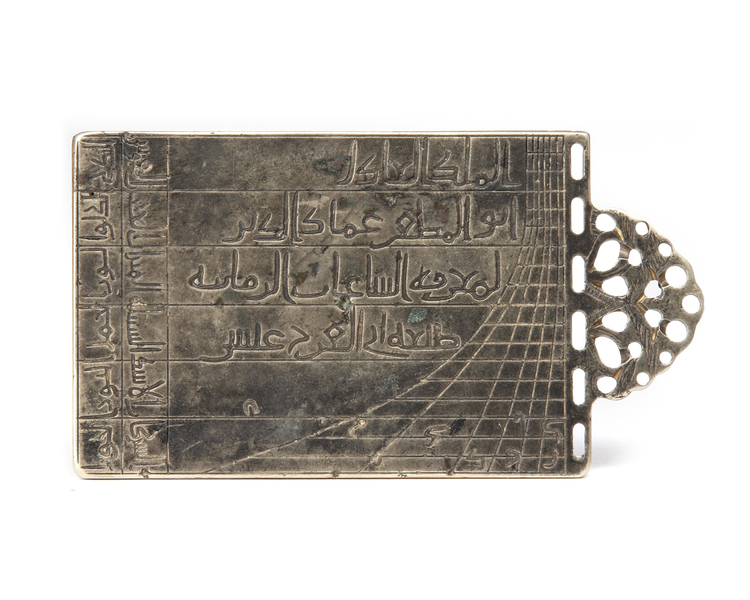A PORTABLE VERTICAL SUNDIAL OF THE “LOCUST LEG TYPE MADE FOR MALIK AL-ADIL ABU MUZAFFAR IMAD AL-DIN (D.1146)
This “locust leg” pocket sundial, made for the Zangid ruler Malik al-Adil Abu Muzaffar Imad al-Din, the famous Turkoman commander known for his known his accomplishments surrounding the Fall of Edessa in 1144, was previously unknown to literature. The instrument is very similar to the exemplar made for the son of Imad al-Din, Nur al-Din Zangi, and which is now kept at the Bibliotheque Nationale in Paris (International Instrument Checklist #7315).
Both instruments are signed by Abu’l Faraj Isa. Previously the Paris instrument was known as the earliest surviving sundial from Islamic Egypt and Syria. Since this instrument is attributed to the father, this instrument is now the oldest known sundial from Islamic Egypt and Syria.
Physical Description
The instrument which is a vertical rectangular flat board made of brass, is 52 mm by x 79 mm (without the throne) in size. It is small enough to fit the palm of ones hand, which might explain the name “locust leg” due to its “humble” size.
The instrument has six slots in the throne to which a gnomon could be fitted.
The gnomon is missing. The throne does not have suspension ring either, although the whole for it seems to be present.
The inscription on the front reads:
الملك العادل
ابو المظفر عماد الدين
لمعرفة الساعات الزمانية
صنعه أبو الفرج عيسى
Al-Malik al- ‘Adil Abu Muzaffar Imad al-Din.
Li-ma’rifat al-Sa’at al-Zamaniyya.
Sana’ahu Abu’l-Faraj Isa.
While the inscription on the reverse reads:
معرفة الساعات الزمانية لعرض لج [on the instrument erronously اساعات ]
Ma’rifat Sa’at al-Zamaniyya Li-‘Arz LJ (33, Damascus)
It is interesting to note that both instruments (Paris and ours) feature some misspellings and errors in the inscriptions and scales of the instrument (which are “silently corrected” in the Paris BNF Instrument catalogue. See, Turner 2018, p.188).
For example, our instrument seems to miss the letter lam connected to the word sa’at in the inscription on the reverse. Perhaps the maker was not an native speaker of Arabic.
The instrument has no date. But inferring from the fact that Imad al-Din, the father died in 1146 and that the Paris instrument is dated 1163/64 [ AH 559], the instrument must be at least 18 years older.
TECHNICAL DESCRIPTION
The instrument is a portable vertical sundial of the type known as “locust’ leg” in medieval Islamic literature. The name is probably inspired by the story of Salomo, to whom all animal presented a gift, and ants presented him a “locust’ leg”, which he accepts, despite being a “humble present”. It is also probably due to this story that in Islamic culture the term “locust’ leg” is known as a humble gift.
The earliest descriptions of how to make such an instrument appear in the work on astronomical instruments authored by the 13th century astronomer al-Marrakushi. The instrument is technically equivalent to the cylindrical sundial where the markings are “wrapped” around a cylinder.
The instrument features a gnomon which is mounted perpendicular on the instrument on top of the graph engraved on the instrument. The gnomon is moved according to the date by means of slots which make it possible to change the position of the gnomon horizontally along the line with slotholes.
Curved hour-lines and declination scales are engraved on both sides of the instrument. Each of the columns correspond to a astronomical sign ( i.e Aries, Taurus) which are labeled in Arabic in a double row at the bottom of the instrument. The curved hour lines are labeled in abjad notation. Each sign is divided into three parts of 10 degrees intervals
It is interesting to note that, while the Paris instrument has on each side markings for a different latitude, this instrument has the same engraving on both sides. This might explain also the reason why there is only latitude inscription on the instrument, which is at the end of the inscription on the reverse ( LJ : 33 degrees, Damascus).
USE OF THE INSTRUMENT
The instrument is suspended perpendicular to the ground perpendicularly such that the gnomon pointed towards to the sun.
LITERATURE
General information on the history of the “Locust Leg” in the medieval:
François Charette, Mathematical Instrumentation in Fourteenth Century Egypt and Syria: The Illustrated Treatise of Najm al-Din al- Miṣrī. Brill, Leiden 2003.
For a detailed analysis of the Paris instrument, see:
Paul Casanova, “La Montre du Sultan Noûr ad dîn l’Hégire = 1159-1160) Syria”, Revue d’Art Oriental et d’Archeologie (Paris), Reprint: Islamic Mathematics and Astronomy series, Vol. 88, Frankfurt 1998, pP. 242-262.
Anthony Turner, Silke Ackermann & Taha Yasin Arslan, Mathematical Instruments in the Collections of the Bibliothèque Nationale de France, BNF Éditions / Brepols, London / Turnhout 2018





